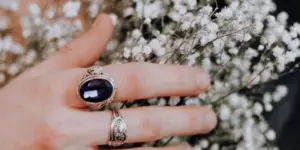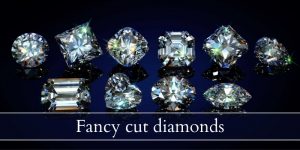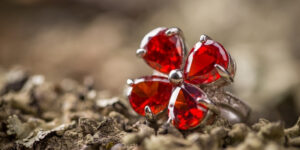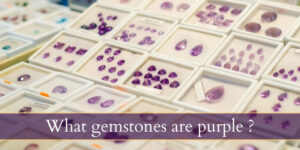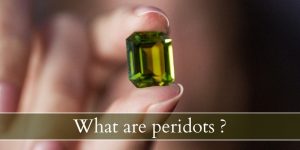When shopping for diamonds you’re often faced with the decision of going for a lab grown diamond, or a natural one. This decision s not as easy as it first sounds, because there’s more to a diamond than meets the eye. And if we’re discussing engagement rings, then this becomes a more delicate matter. Everyone is different and so is their take on natural vs lab grown diamonds.
Let’s discuss the key differences between lab grown diamonds and natural diamonds, so you have a better idea of how similar or different they are from one another.
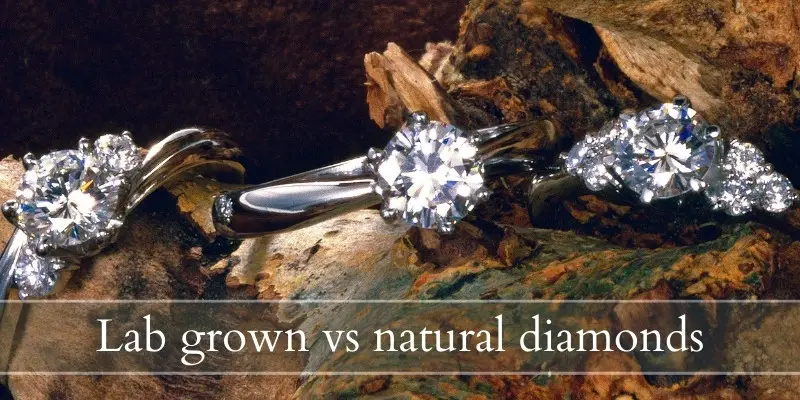
Lab grown vs natural diamonds
Lab grown diamonds are the more affordable, conflict-free version of natural diamonds. Natural diamonds are formed deep within the Earth’s mantle and brought up volcanoes and tectonic plate movements, while lab diamonds are formed in a controlled environment. Where a natural diamond has the element of rarity and prestige, a lab grown diamonds has affordability and ethics on its side.
In the end the decision of which to buy is entirely up to you. But let’s discuss this further, since this is a big topic that needs quite a bit of details. You probably have a whole slew of questions, so let’s start with the most obvious one.
What are lab-grown diamonds ?
Lab grown diamonds are 100% chemically the same as natural diamonds, only they are grown in a controlled environment, in a much shorter time span than a natural diamond.
Lab grown diamonds are identical to natural diamonds in every way that counts, such as possible cuts, color, clarity, and carat weight. A jeweler cannot easily tell the difference between natural and lab grown diamonds, as special equipment is needed.
Read also: Do Diamonds Come From Coal ?
Do not confuse lab grown diamonds for diamond simulants. Lab grown diamonds are not moissanite or cubic zirconia ! Those are often used as diamond dupes but are made of entirely different materials. While a lab grown diamond is made of carbon, moissanite is made of silicon carbine and cubic zirconia of zirconium dioxide.
Alright, now let’s take a closer look at natural and lab grown diamonds compared side by side, starting with the most obvious difference.
Lab grown diamonds are more affordable compared to natural diamonds
Lab diamonds tend to be about 30-40% lower in price than natural diamonds. This is because of two things. First, natural diamonds come with some prestige, so they will fetch a high price by default. When you take the prestige out of the diamond, it’s left with a far lower price.
Second, a lab grown diamond is easier to produce, as in easier to get from the lab and onto an engagement ring. A natural diamond must be dug up, mined, and transported before it can be cut and graded. This is a set of expensive steps that add to the overall cost of a natural diamond.
So if price is a big consideration for you a lab grown diamond will be far easier to reach than a natural diamond. And when it comes to diamonds, prices are always pretty steep.
Natural diamonds are natural, traditional, and have prestige
Natural diamonds come with tradition, prestige, they’re expected even. When you say you got a diamond ring, most people will assume a natural diamond. This is because that’s been the status quo for many, many centuries and it’s difficult to change.
And in truth there is some prestige that comes with owning a piece of rock that is billions of years old, from deep within the Earth…right on your finger. A rare treat for most people.
Lan grown diamonds simply do not have this feeling of prestige to them. Their very name makes people think of ‘fake’, ‘cheap’, and possibly even not worth considering. In truth no one will be able to tell the difference by just looking at the diamond, unless you tell them. But you’ll know, and for some that is enough.
Lab grown diamonds are 100% conflict free, less damaging to the environment
A key feature of lab-grown diamonds is that they’re 100% conflict free, meaning they are not mined and thus do not offer the possibility of having humans exploited. Natural diamonds go through the Kimberley process since 2008, which is a form of ensuring every single diamond can be reliably traced back to the original mine. the diamonds are encased in a sealed box than cannot be opened until the diamond is to be cut and sold.
That being said, there are still countries that do no adhere to this process, and some diamonds out of Africa are still used a currency to sell weapons and fuel wars.
Also, lab grown diamonds do consume quite a bit of energy during production. This is not environmentally friendly, but it is less damaging than traditional diamond mining.
The four Cs with dealing with natural and lab grown diamonds
You might we wondering how a lab grown diamond compares to a natural diamond, in terms of its four most important grading points: cut, clarity color, and carat. Well, that is a valid concern so let’s explore this.
Are lab grown diamonds as clear as natural diamonds ?
yes, lab grown diamonds are able to achieve the same level of clarity as a natural diamond. A natural diamond’s clarity is dictated by its lack of inclusions, which are trace amounts of other elements that have agglomerated into noticeable shapes or concentrations within the diamond. The less inclusions there are, the clearer the diamond. The clearer the diamond the better it looks, and the better it will reflect light back to you.
Lab grown diamonds are grown in a controlled environment, so their inclusions are easily controlled – added intentionally or made sure they don’t exist in concentrations large enough to be seen with a jeweler’s loupe (10x magnification).
Are lab grown diamonds as colorless (white) as natural diamonds ?
Yes, lab grown diamonds can be just as colorless (white) as natural diamonds. Natural diamonds usually have a coloration ranging from perfectly clear/white to pale yellow to light brown. This color is due to trace amounts of hydrogen.
Hydrogen is a key element in all diamonds, be they lab grown or natural. The presence of a tiny amount of hydrogen ensures the crystal lattice of the diamond is stable, and ensures diamond’s famous hardness.
So, lab grown diamonds can have more hydrogen introduced to them to get a pale yellow color, or just enough hydrogen to make them durable but still remain white (or graded D for color). In fact it’s easier to obtain perfectly white diamonds in a lab, than to find one in nature.
An interesting thing to note: lab diamonds are far easier to find in fancy colors (pink, blue, canary yellow, etc) than natural diamonds since the color can easily be induced while the diamond is grown.
Are lab grown diamonds as large as natural diamonds ?
Lab grown diamonds tend to be stopped from growing once they reach the 1.5 carat mark, and produce 1 carat cut diamonds. The largest lab grown diamond was cut into a 10 carat square emerald cut, taken from a 32.2 carat rough. The reason lab grown diamonds cannot produce very large rough is because of the limited space they can grow in. The enclosed capsule must be easy to control, and this is easier done with a smaller space.
Natural diamonds come in various carats and the largest ever rough was over 3000 carats. That being said the general public does not usually buy above 5 carats, with 1 carat diamonds being the most common in engagement rings. For bracelets, earrings, and pendants the carat size of each diamond is usually smaller.
Can lab grown diamonds be cut the same as natural diamonds ?
Yes, lab grown diamonds can be cut the same as any natural diamond. They have the same clarity and inclusion rate as a natural diamond, so any cut style will work on lab grown diamonds.
Lab grown diamonds FAQ
You might be wondering a few thing about lab grown diamonds. Below are the most common questions we’ve encountered, and hopefully you’ll find the answer for your specific question.
How long does it take to make a lab grown diamond ?
Lab grown diamonds are usually complete in about 4 months. The length of time needed to form a lab grown diamond depends on a few factors:
- nitrogen presence, less nitrogen equals slower growth
- how large the final carat size should be, larger one take larger to grow
Do lab grown diamonds have resale value ?
Lab grown diamonds do have resale value, but it will always be lower than a natural diamond’s resale value. This is because of the same reasons a lab grown diamond is always lower in price than a natural diamond, when first bought.
Do lab grown diamonds turn yellow ?
No, lab grown diamonds do not turn yellow in time. Lab grown diamonds are as chemically stable as a natural diamond, which does not turn yellow in time.
Can a jeweler spot a lab grown diamond ?
A jeweler may not easily spot a lab grown diamond, and they usually don’t have the required equipment. If you want to know if your diamond is lab grown, you should send it to one of the grading laboratories such as GIA or IGI. There they will be able to look at the diamond with spectroscopic devices and give you a straight answer.
Are lab grown diamonds tacky ?
No, lab grown diamonds are not tacky as they are 100% identical to color and clarity and chemical makeup as a natural diamond. Lob grown diamonds are also not cheap, despite being more affordable than a natural diamond. No one will know you’re wearing a lab grown diamond unless you tell them.
Can you insure a lab grown diamond ?
Yes, you can insure a lab grown diamond the same way you can insure a natural diamond. The overall insurance will be lower because the total price of the diamond will be lower, so you’re not paying a fortune.
Do lab grown diamonds scratch ?
No, lab grown diamonds do not scratch as they are the exact same as a natural diamond in terms of hardness. Wearing your lab grown diamond every day will not make it accumulate more scratches than a natural diamond would.
Do not confuse lab grown diamonds for moissanite or cubic zirconia. Cubic zirconia can scratch easier than moissanite, while moissanite is almost impossible to scratch.
Do lab grown diamonds sparkle less ?
No, lab grown diamonds do not sparkle less. They have a good crystal lattice and clarity, just like a natural diamond. So it will sparkle and reflect as much light as a natural diamond would. A diamond’s sparkle is largely dependent on its cut quality, and the cut quality is the same for lab grown diamonds and natural diamonds.
There is also the refractive index to take into account, which is the degree at which the light is bent as it enters the diamond. Both natural and lab grown diamonds have a reflective index of 2.42.
Can lab grown diamonds be certified ?
Yes, lab grown diamonds can be certified, and most of them do come certified by either GIA or IGI. If you’re unsure about the quality of your diamond you can send it to one the two diamond grading companies and it will most likely come back with a certificate.

I’m the main author for jewelrymaterialguide.com. I started this site after we did tons of research before our wedding and noticed that there is information about rings, jewelry, and so on that is really hard to find on the internet.


